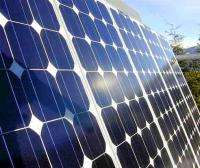August 16, 2013 weblog
New research suggests perovskite as cheaper replacement for silicon-based solar panels

(Phys.org) —Researchers at Oxford Photovoltaics and other companies investigating the use of perovskite—a crystalline organometal—as a replacement for silicon in photovoltaic cells have created prototypes that are approximately 15 percent efficient. But this is apparently just the beginning. Kevin Bullis suggests in an article published this week in MIT Technology Review, that researchers are predicting efficiencies as high as 25 percent very soon, putting the material on a par with silicon.
Simply meeting the same efficiency levels as silicon isn't a big deal of course, other materials have been found that are capable of doing so as well, what's newsworthy here is that using perovskite to make solar cells would be far cheaper. Not only is it more readily available, but it doesn't require as much production cost. Also, cells that use it would require far less material. Silicon cells, for example, typically wind up approximately 180 micrometers thick. A comparable cell made using perovskite on the other hand would be just 1 micrometer thick.
Perovskite isn't some newly discovered material—scientists have known about it for over 170 years. What's new is that researchers are only now beginning to fully realize its potential as a material for use in solar cell technology. It was only in 2009 that researchers first thought of using the semiconductor in such cells—initial testing indicated that it was only 3.5 percent efficient. Worse, it didn't hold up for very long when used. But since that time, researchers have figured out how to make it last longer and have continuously improved its efficiency to boot.
Current prototypes are made using a process that involves spraying the material on a base, which means the material is far more versatile than silicon as well. But what really has researchers exited are expectations for creating solar panels far more cheaply than can be done today—estimates suggest they could cost just 10 to 20 cents per watt, as compared to 75 cents per watt for traditional silicon based panels—fossil fuels cost an average of 50 cents per watts, suggesting that the use of perovskite could cause a dramatic shift to solar power in the future if its efficiency can be improved as researchers hope.
More information: Oxford Photovoltaics: www.oxfordpv.com/photovoltaic-cell-technology.html
via MIT Tech Review
© 2013 Phys.org




















